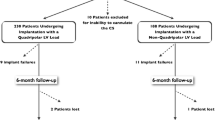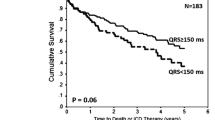Abstract
Background
Cardiac resynchronization therapy (CRT) is an effective treatment for heart failure (HF); however, a third of patients are non-responders. The development of quadripolar left ventricular (LV) lead was shown, mainly in single manufactures’ registry, to improve LV remodeling and overall mortality. However, limited reports exist on the impact of quadripolar LV leads on HF hospitalization rates in real-life cohorts. We evaluated the clinical outcomes associated with quadripolar LV leads in a large nation-wide registry including all patients implanted with a cardiac resynchronization therapy with defibrillator (CRT-D).
Methods
Between July 2010 and October 2016, 2913 consecutive patients were implanted with a CRT-D and all were prospectively enrolled in the Israeli ICD Registry. Quadripolar LV leads were implanted in 973 (33.4%) patients during this period, and their clinical outcomes were compared to CRT-D recipients implanted with a bipolar LV lead. Primary endpoint was HF hospitalization rate.
Results
Quadripolar leads were implanted more in patients with non-ischemic cardiomyopathy and for primary prevention indication and less in post-infarction patients and for secondary prevention of sudden death. Longer QRS duration was observed with quadripolar leads (147 ± 23 vs 143 ± 25; p < 0.001). Outcome event rate for 100 patient years revealed no difference in HF hospitalization rates between bipolar and quadripolar LV leads. Quadripolar lead implant led to lower cardiac mortality, with no influence on overall mortality. Multivariate analysis revealed no significant differences in study endpoints between bipolar and quadripolar LV leads.
Conclusion
In a large real-life registry, implantation of quadripolar LV leads in patients with CRT-D did not influence HF hospitalization rates.


Similar content being viewed by others
References
European Society of C, European Heart Rhythm A, Brignole M, Auricchio A, Baron-Esquivias G, Bordachar P, et al. 2013 ESC guidelines on cardiac pacing and cardiac resynchronization therapy: the task force on cardiac pacing and resynchronization therapy of the European Society of Cardiology (ESC). Developed in collaboration with the European Heart Rhythm Association (EHRA). Europace. 2013;15(8):1070–118. https://doi.org/10.1093/europace/eut206.
Russo AM, Stainback RF, Bailey SR, Epstein AE, Heidenreich PA, Jessup M, et al. ACCF/HRS/AHA/ASE/HFSA/SCAI/SCCT/SCMR 2013 appropriate use criteria for implantable cardioverter-defibrillators and cardiac resynchronization therapy: a report of the American College of Cardiology Foundation appropriate use criteria task force, Heart Rhythm Society, American Heart Association, American Society of Echocardiography, Heart Failure Society of America, Society for Cardiovascular Angiography and Interventions, Society of Cardiovascular Computed Tomography, and Society for Cardiovascular Magnetic Resonance. Heart Rhythm. 2013;10(4):e11–58. https://doi.org/10.1016/j.hrthm.2013.01.008.
Solomon SD, Foster E, Bourgoun M, Shah A, Viloria E, Brown MW, et al. Effect of cardiac resynchronization therapy on reverse remodeling and relation to outcome: multicenter automatic defibrillator implantation trial: cardiac resynchronization therapy. Circulation. 2010;122(10):985–92. https://doi.org/10.1161/CIRCULATIONAHA.110.955039.
Moss AJ, Hall WJ, Cannom DS, Klein H, Brown MW, Daubert JP, et al. Cardiac-resynchronization therapy for the prevention of heart-failure events. N Engl J Med. 2009;361(14):1329–38. https://doi.org/10.1056/NEJMoa0906431.
Bristow MR, Saxon LA, Boehmer J, Krueger S, Kass DA, De Marco T, et al. Cardiac-resynchronization therapy with or without an implantable defibrillator in advanced chronic heart failure. N Engl J Med. 2004;350(21):2140–50. https://doi.org/10.1056/NEJMoa032423.
van Bommel RJ, Bax JJ, Abraham WT, Chung ES, Pires LA, Tavazzi L, et al. Characteristics of heart failure patients associated with good and poor response to cardiac resynchronization therapy: a PROSPECT (Predictors of Response to CRT) sub-analysis. Eur Heart J. 2009;30(20):2470–7. https://doi.org/10.1093/eurheartj/ehp368.
Rinaldi CA, Burri H, Thibault B, Curnis A, Rao A, Gras D, et al. A review of multisite pacing to achieve cardiac resynchronization therapy. Europace. 2015;17(1):7–17. https://doi.org/10.1093/europace/euu197.
Singh JP, Klein HU, Huang DT, Reek S, Kuniss M, Quesada A, et al. Left ventricular lead position and clinical outcome in the multicenter automatic defibrillator implantation trial-cardiac resynchronization therapy (MADIT-CRT) trial. Circulation. 2011;123(11):1159–66. https://doi.org/10.1161/CIRCULATIONAHA.110.000646.
Saxon LA, Olshansky B, Volosin K, Steinberg JS, Lee BK, Tomassoni G, et al. Influence of left ventricular lead location on outcomes in the COMPANION study. J Cardiovasc Electrophysiol. 2009;20(7):764–8. https://doi.org/10.1111/j.1540-8167.2009.01444.x.
Behar JM, Bostock J, Zhu Li AP, Chin HM, Jubb S, Lent E, et al. Cardiac resynchronization therapy delivered via a multipolar left ventricular lead is associated with reduced mortality and elimination of phrenic nerve stimulation: long-term follow-up from a multicenter registry. J Cardiovasc Electrophysiol. 2015;26(5):540–6. https://doi.org/10.1111/jce.12625.
Turakhia MP, Cao M, Fischer A, Nabutovsky Y, Sloman LS, Dalal N, et al. Reduced mortality associated with quadripolar compared to bipolar left ventricular leads in cardiac resynchronization therapy. JACC: Clin Electrophysiol. 2016;2(4):426–33. https://doi.org/10.1016/j.jacep.2016.02.007.
Behar JM, Chin HMS, Fearn S, Ormerod JOM, Gamble J, Foley PWX, et al. Cost-effectiveness analysis of quadripolar versus bipolar left ventricular leads for cardiac resynchronization defibrillator therapy in a large, multicenter UK registry. JACC: Clin Electrophysiol. 2017;3(2):107–16. https://doi.org/10.1016/j.jacep.2016.04.009.
Forleo GB, Di Biase L, Bharmi R, Dalal N, Panattoni G, Pollastrelli A, et al. Hospitalization rates and associated cost analysis of cardiac resynchronization therapy with an implantable defibrillator and quadripolar vs. bipolar left ventricular leads: a comparative effectiveness study. Europace. 2015;17(1):101–7. https://doi.org/10.1093/europace/euu290.
Leyva F, Zegard A, Qiu T, Acquaye E, Ferrante G, Walton J, et al. Cardiac resynchronization therapy using quadripolar versus non-quadripolar left ventricular leads programmed to biventricular pacing with single-site left ventricular pacing: impact on survival and heart failure hospitalization. J Am Heart Assoc. 2017;6(10):e007026. https://doi.org/10.1161/JAHA.117.007026.
Amit G, Suleiman M, Konstantino Y, Luria D, Kazatsker M, Chetboun I, et al. Sex differences in implantable cardioverter-defibrillator implantation indications and outcomes: lessons from the Nationwide Israeli-ICD Registry. Europace. 2014;16(8):1175–80. https://doi.org/10.1093/europace/euu015.
Leshem E, Suleiman M, Laish-Farkash A, Konstantino Y, Glikson M, Barsheshet A, et al. Contemporary rates and outcomes of single- vs. dual-coil implantable cardioverter defibrillator lead implantation: data from the Israeli ICD Registry. Europace. 2016; https://doi.org/10.1093/europace/euw199.
Ziacchi M, Saporito D, Zardini M, Luzi M, Quartieri F, Morgagni G, et al. Left ventricular reverse remodeling elicited by a quadripolar lead: results from the multicenter Per4mer study. Pacing Clin Electrophysiol. 2016;39(3):250–60. https://doi.org/10.1111/pace.12792.
Zanon F, Martignani C, Ammendola E, Menardi E, Narducci ML, de Filippo P, et al. Device longevity in a contemporary cohort of ICD/CRT-D patients undergoing device replacement. J Cardiovasc Electrophysiol. 2016;27(7):840–5. https://doi.org/10.1111/jce.12990.
Steinhaus DA, Waks JW, Collins R, Kleckner K, Kramer DB, Zimetbaum PJ. Effect of smaller left ventricular capture threshold safety margins to improve device longevity in recipients of cardiac resynchronization-defibrillation therapy. Am J Cardiol. 2015;116(1):85–7. https://doi.org/10.1016/j.amjcard.2015.03.047.
Calo L, Martino A, de Ruvo E, Minati M, Fratini S, Rebecchi M, et al. Acute echocardiographic optimization of multiple stimulation configurations of cardiac resynchronization therapy through quadripolar left ventricular pacing: a tailored approach. Am Heart J. 2014;167(4):546–54. https://doi.org/10.1016/j.ahj.2013.12.028.
Rickard J, Michtalik H, Sharma R, Berger Z, Iyoha E, Green AR, et al. Predictors of response to cardiac resynchronization therapy: a systematic review. Int J Cardiol. 2016;225:345–52. https://doi.org/10.1016/j.ijcard.2016.09.078.
Acknowledgements
The authors thank Mrs. Michal Einhorn and Mr. Nir Shlomo from the Israeli Association for Cardiovascular Trials (IACT) for their assistance in the data retrieval and statistical analysis.
Author information
Authors and Affiliations
Consortia
Corresponding author
Ethics declarations
Competing interests
The authors declare that they have no competing interests.
Additional information
All authors take full responsibility for all aspects of the reliability and freedom from bias of the data presented and their discussed interpretation.
Electronic supplementary material
ESM 1
(DOCX 21 kb)
Rights and permissions
About this article
Cite this article
Leshem, E., Suleiman, M., Laish-Farkash, A. et al. Impact of quadripolar LV leads on heart failure hospitalization rates among patients implanted with CRT-D: data from the Israeli ICD Registry. J Interv Card Electrophysiol 51, 5–12 (2018). https://doi.org/10.1007/s10840-017-0305-z
Received:
Accepted:
Published:
Issue Date:
DOI: https://doi.org/10.1007/s10840-017-0305-z




